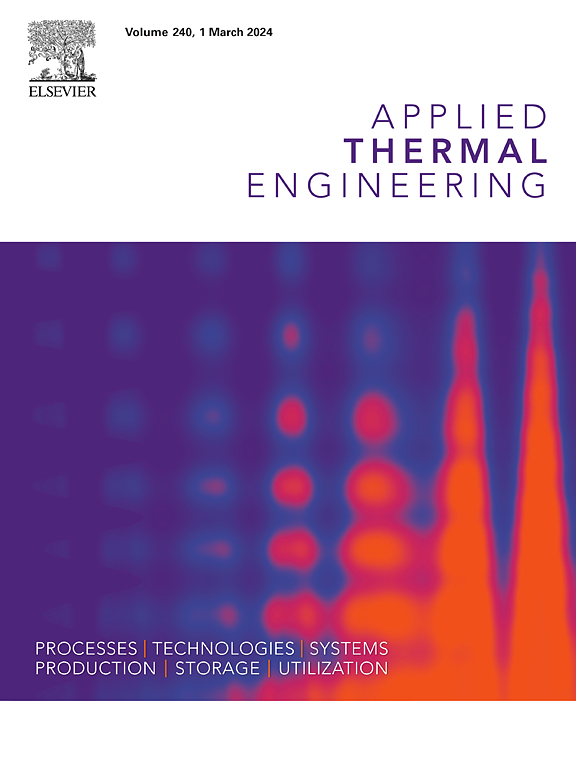Performance assessment and emission implications of an ammonia co-combustion power system with various coal ranks
IF 6.9
2区 工程技术
Q2 ENERGY & FUELS
引用次数: 0
Abstract
Ammonia (NH3)-coal co-combustion has been identified as a key strategy for decarbonizing coal-fired power generation. Large-scale implementation requires a comprehensive investigation into co-combustion behaviour, considering the influence of coal properties on system performance. The variability in coal composition and the resulting flue-gas characteristics necessitate detailed analysis, as their direct effect on system efficiency and emissions is significant. This study presents a simulation of NH3 co-combustion in a 1 GW ultra-supercritical power cycle, evaluating five different coals (bituminous, sub-bituminous, and three lignite coals) with co-combustion ratios ranging from 0 to 0.5. The findings of this study demonstrated a decline in net efficiency, concomitant with a decrease in calorific values of coal and an increase in co-combustion ratios. The variation in coal compositions also significantly influenced the combustion-temperature trends and thereby the flue-gas composition (especially the NOx emission). In addition, the properties of the flue-gas had a discernible impact on boiler efficiency and heat-exchange performance. A distinct correlation was observed between boiler efficiency and the primary flue-gas constituents, H2O, CO2, and N2 across different coal ranks, both in terms of molar-flow rate and concentration. A general decrease in the log mean temperature difference (LMTD) was observed as the coal rank shifted from bituminous to lignite. However, with rising co-combustion ratios, a trend reversal was observed in all the lignite coals, with LMTD profiles transitioning from decreasing to increasing, in contrast to the behaviour seen with higher-rank coals. This study provides a comprehensive analysis of NH3 co-combustion with various coal ranks—offering insights that lay the foundation for the widespread large-scale adoption of relevant technologies.
不同煤阶氨共燃电力系统的性能评价及排放影响
氨煤共燃已被确定为燃煤发电脱碳的关键策略。考虑到煤的性质对系统性能的影响,大规模实施需要对共燃行为进行全面的研究。煤成分的变化和由此产生的烟气特征需要详细分析,因为它们对系统效率和排放的直接影响是显著的。本研究在1gw超超临界功率循环中模拟了NH3共燃,评估了5种不同的煤(烟煤、亚烟煤和3种褐煤),共燃比在0到0.5之间。这项研究的结果表明,净效率下降,伴随着煤的热值下降和共燃比增加。煤成分的变化也显著影响燃烧温度趋势,从而影响烟气成分(特别是NOx排放)。此外,烟气的性质对锅炉效率和换热性能也有明显的影响。锅炉效率与不同煤种的主要烟气组分H2O、CO2和N2在摩尔流量和浓度方面存在明显的相关性。随着煤阶由烟煤向褐煤的转变,其对数平均温差(LMTD)普遍减小。然而,随着共燃比的增加,在所有褐煤中都观察到趋势逆转,LMTD曲线从减少到增加,与高阶煤的行为相反。本研究对不同煤种的NH3共燃进行了全面分析,为相关技术的广泛大规模应用奠定了基础。
本文章由计算机程序翻译,如有差异,请以英文原文为准。
求助全文
约1分钟内获得全文
求助全文
来源期刊

Applied Thermal Engineering
工程技术-工程:机械
CiteScore
11.30
自引率
15.60%
发文量
1474
审稿时长
57 days
期刊介绍:
Applied Thermal Engineering disseminates novel research related to the design, development and demonstration of components, devices, equipment, technologies and systems involving thermal processes for the production, storage, utilization and conservation of energy, with a focus on engineering application.
The journal publishes high-quality and high-impact Original Research Articles, Review Articles, Short Communications and Letters to the Editor on cutting-edge innovations in research, and recent advances or issues of interest to the thermal engineering community.
 求助内容:
求助内容: 应助结果提醒方式:
应助结果提醒方式:


